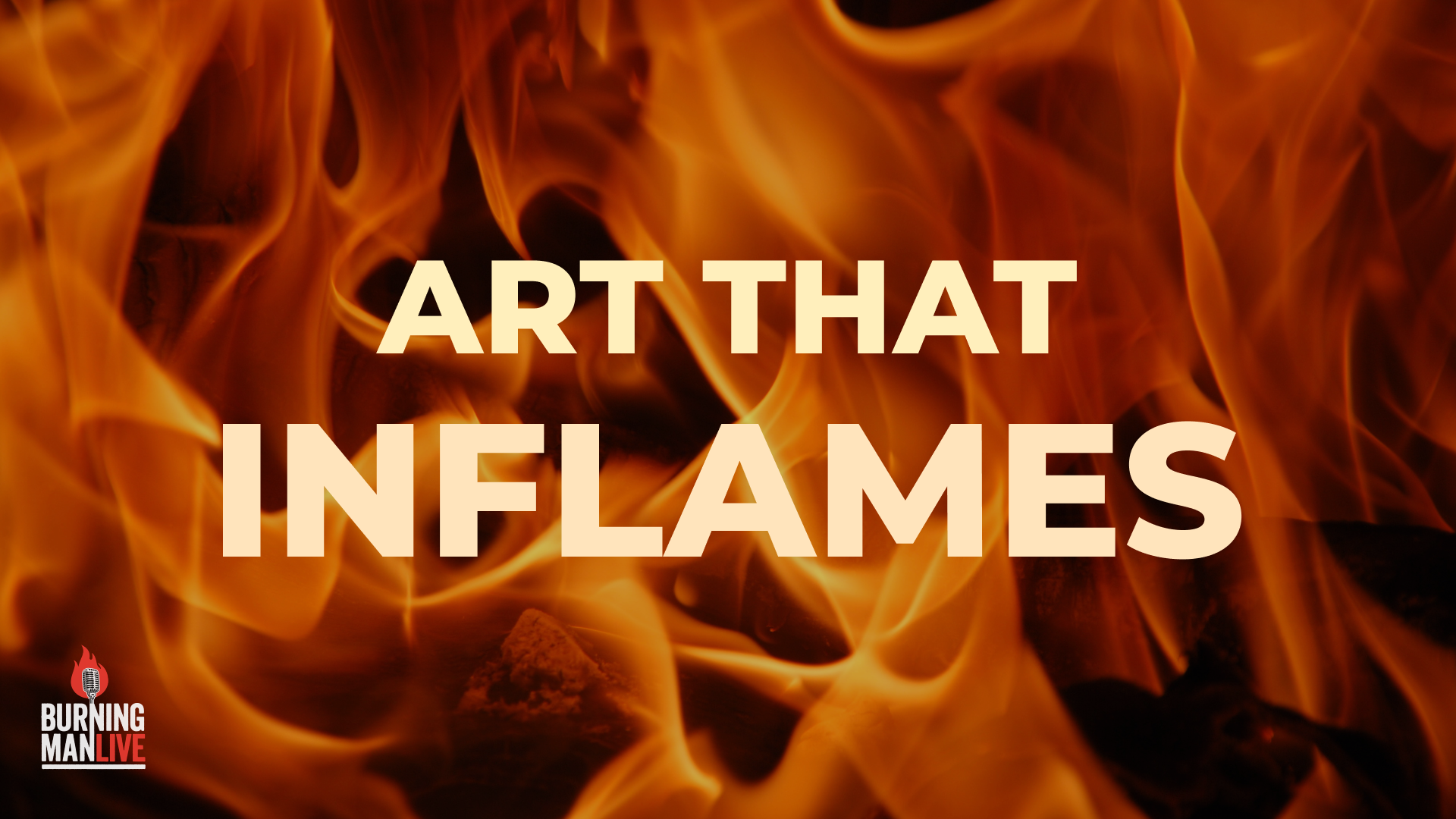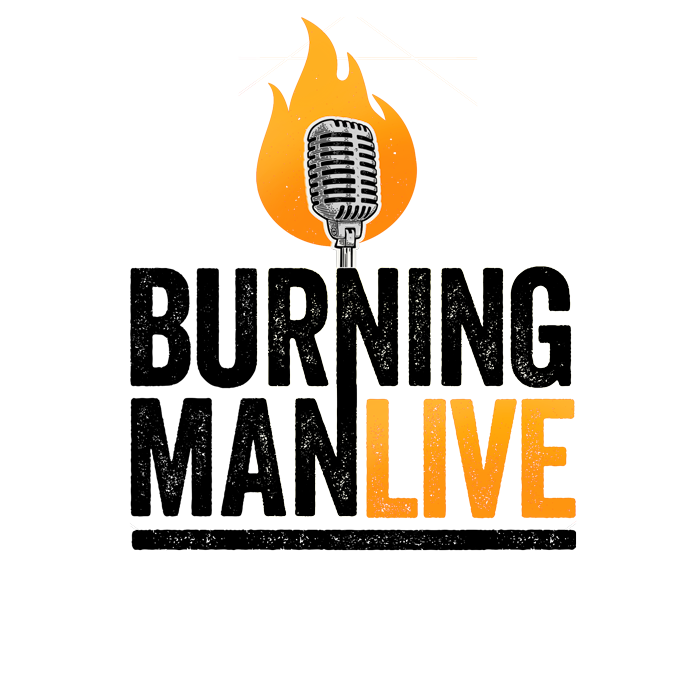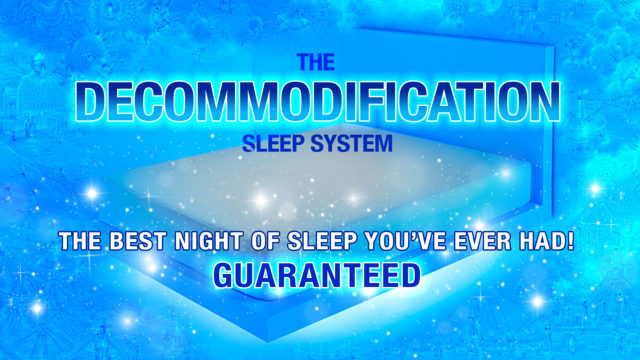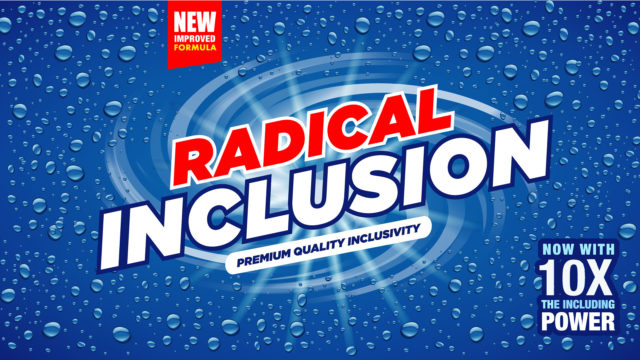
Art That Inflames
Burning Man culture brings people together across all kinds of divides, yet we’re seeing an uptick of intolerance toward art and experiences in our community. The default world is often divided by ideology, religion, and politics. Could that division seep into this culture that aspires to welcome everyone?
How can we navigate the turbulent waters between, say, Radical Self-expression and Radical Inclusion? How do we walk the line between free speech and hate speech? How do we keep our global community together in times of outright war?
Listen in on a roundtable discussion about concerns that don’t have easy solutions. A few folks explore how the act of conversation changes what might otherwise seem controversial or divisive:
• Stuart Mangrum is Burning Man Project’s Director of the Philosophical Center so he directed some philosophers to center around a microphone to discuss.
• Caveat Magister debated and discussed Burning Man philosophy, then wrote books about it.
• Kay Morrison is a veteran Black Rock City artist, active in the Global Network, and a Burning Man Project board member.
• Steven Raspa is Associate Director of Community Events for Burning Man Project, and a co-founder of the Regional Network Committee.
This conversation concerns art, yes, and behavior — as participants, as people. It’s about being open-minded and open-hearted, even when it’s difficult to do. What is a safe space? What is a brave space? How can jackassery be respectful? What’s with all the questions? Tune in for the answers that lead to more questions.
burningman.org/about/10-principles
Turn Your Life Into Art with Caveat Magister (Burning Man LIVE)
Kay Morrison and the Overall Wonderment Quotient (Burning Man LIVE)
Remember How to Burning Man with Steven Raspa (Burning Man LIVE)
Stuart Mangrum’s Serious Philosophy of Shenanigans (Burning Man LIVE)
Transcript
STUART:
Hey, everybody. You know, for me, the real power of Burning Man culture, it’s not the freshly cooked beignets at Beignet Camp. It’s not the music. It’s the amazing ability to bring people together across all kinds of divides. And God knows, we live in a fractured and divided world, divided by lines of ideology, by religion, by politics, by outright war.
And it just seems, though, it’s getting more and more fractured all the time. And I’m worried; I see signs that that division out in the rest of the world is starting to creep its way into our comfortable little Burning Man bubble, our little pocket universe where everyone is welcome and everyone wants to get along.
So how as a community are we supposed to navigate these increasingly turbulent waters between, say, Radical Self-expression on the one hand, and Radical Inclusion on the other? How do we walk the line between free speech and hate speech? Ya know, and who’s to decide what that is? And how do we keep our global community together in times of outright war?
So these questions are all above my pay grade. I know I’ve got a fancy title about philosophy, but I brought in a few friends who are better at this than I am. They’re all friends of the show. If you’ve been listening awhile, you’ve probably met all of them before.
I have Caveat Magister, who is an actual philosopher of Burning Man, actually wrote a book about Burning Man philosophy.
I have Kay Morrison, who is very active in the international Burner scene, the Global Network, an artist in her own right, and a Burning Man Project board member.
And I have my friend Steven Raspa who I always say that if Burning Man were a country, and it kind of is, he would be our Secretary of State; also very deep into the global Burning Man community.
I should mention that the goal here is not to come up with some kind of broad edict or policy statement from Burning Man Project to the rest of the culture at large. It’s really just to help frame the discussion, to do a little bit of deeper thinking about some things that don’t have easy solutions with some people who’ve done a lot of thinking about this sort of thing. Individual mileage may vary, and the opinions of the philosophers are always their own.
So why don’t we start with the increasing levels of intolerance that we’re seeing around art; rising levels of art vandalism. What is it? Are people just getting more sensitive, do you think? Or is the art getting more provocative? Caveat?
CAVEAT:
Well, I’ll start by saying, I don’t know, just to cover all of our bases there. I think there is a way in which something new is happening, and there’s a way in which something is happening over again. I mean, the times are different, absolutely, but there are some ways in which this discussion isn’t. I feel like this is very much the same kind of conversation that we were having about radical inclusion in 2018, in 2012, in, I don’t know, 1996, which is even before there was a principle of Radical Inclusion.
And I think, sort of the fundamental dynamic has always been the same, that we don’t want to make art and create experiences with those people, they’re exclusive, but, we just don’t want to play with them. And yet, of course, Burning Man is at its very best when we figure out ways to make art and create experiences with everyone we possibly can.
What’s different now is that it’s getting harder and harder to convince people of the value of inclusivity, because our times are so much more polarized. We are not as separate from the world as we want to think we are, and the world is getting harsher and harsher in this regard. And it’s showing up in our doorstep. But I think the fundamental discussion is one that we have had again and again and again. And the answer to me in some ways remains the same, which is, yeah, this is hard. This isn’t easy.
Radical inclusion is difficult. And if it’s not in some way difficult or at least uncomfortable, then you’re probably not being radically inclusive. You’re probably just hanging out with the people you’d want to hang out with anyway. So, I think the underlying dynamic for Burning Man is the same, but the world has gotten so much less tolerant and so much less willing to give people a chance and so much more inclined to just knee-jerk condemn. And we’re seeing a seepage of that into our community.
STUART:
You think skins are getting thinner and triggers are getting more hair trigger? I just keep hearing that word more and more. We used to say, “I just don’t like that.” Now you say “I’m triggered by that.” Is this something that we’re seeing out in the rest of the Burnerverse, as well as in Black Rock City?
KAY:
I don’t know, I just want to call out some of the linguistics around it, that the word intolerance only exists because the word tolerance was there first. So intolerance means that at some point, you know, we had tolerance and then we had the diversion from tolerance, which I think can be applied to Black Rock City and Burner culture.
I remember in the early 2000s feeling like everyone was accepted and everything was tolerated. And it was like this beautiful place where you had permission to be weird and to do these wonderful things. And it just created this sense of awe. And so how could you possibly think about fucking something up that just brought so much awe? That one piece of the collective awesomeness of Burning Man was so important. It was so important.
And I think that tolerance also empowered people to feel like they were being heard and being seen, that they had a voice. That tolerance was giving them permission to speak their truth, to speak their weird, to do an art piece for all of the different shades of urine, which blew my mind that year. I was really questioning my life decisions at that art project.
But I think what we’re seeing… Intolerance is feeling someone’s voice is crushing out yours, or that someone’s taking something from you. So intolerance of art on the playa. I feel, people who do vandalize or who critique are people whose own voices aren’t feeling heard and they maybe don’t have the tools or the confidence or the access or ability to figure out how to say what they need to say. And so instead of doing that, they’re taking away the voice from someone else.
STUART:
I remember a day when there was some truly offensive art, and I had a hard time, even myself, not getting offended by the Aesthetic Meat Foundation, that brought out giant slabs of meat that progressively rotted over the course of the event. Or, the famous Barbie Death Camp… Raspa, you were probably there at all stages of the Barbie Death Camp — Barbie Death Village adventure.
RASPA:
Definitely, including more recently when some participants decided that they were so offended by the piece that they physically attacked the artist who made the Barbie Death Camp display and attacked the art piece.
I’m sure in that moment that they thought that they had moral grounds to do so, that somehow the depiction of Barbie being escorted by Nazis into an oven had crossed a line for them, and that they were somehow standing for some sense of moral good in the world.
If they had spoken with the artist to find out that they are of Jewish origin, that they actually, that this is a deeply personal piece to them, maybe they would not have been so quick to resort to violence.
And to Kay’s point, yeah, there was a time where offending one’s senses was even part of the Burning Man experience; that it was indeed a place where you could make extreme statements and not feel at risk of being censored in some way. And then all around that, have difficult conversations.
You raised an interesting point earlier, is this polarization in Black Rock City a reflection of what’s going on in society? Absolutely. And I think it’s up to us and our community to actually have the difficult conversations about these things. And I think that’s what Black Rock City is good for.
And I would urge people that if they feel offended or they’re deeply even moved in a positive way, as well as a negative way, and they can’t quite understand what the heck is going on, to potentially seek out the artist, or do research and find out about the intention, or even have a conversation with the person about how it is impacting you.
Not to say that the artist shouldn’t necessarily consider the impact of their work either. I’m not into censorship in any way, shape, or form. But I think that Black Rock City is a pretty special canvas in which we are trying to engender a sense of community and togetherness. So if you know, as an artist, that your work is going to pull some serious levers in people, then maybe you should at least be willing to have conversations and talk to people about it, and not drop a potential mental bomb someplace and walk away from it.
I’m sure others in the community might disagree with me and say art stands on its own and should never be questioned, but I think our community is about conversation. So I’m all for nudging people together and finding out intention, having difficult conversations, and having shared experience that furthers relationships through potentially divisive or controversial art.
CAVEAT:
Yeah, I think we need to remember along those lines, that being offended is a perfectly legitimate reaction to art.
KAY:
Yeah.
CAVEAT:
…and that saying, “Hey, I’m offended. I don’t like this,” is entirely in keeping with radical self-expression. We don’t want people to say, “Well, I’m offended, but I better keep it to myself.” That’s not radical self-expression. That is not what our community is about.
The question is, can we then take those reactions and as Steven says, turn them into a conversation, however difficult, as opposed to simply sort of throwing things at each other or trying to shut one another down? Shutting each other down is not in keeping with the 10 Principles. Having the hard conversations very much is.
STUART:
And it seems that rather than have the conversation, though, people are increasingly wanting to either have a confrontation, take the law into their own hands, or call mom.
KAY:
What?
STUART:
Ask the Rangers to take care of the problem for them. We actually have that happening. Here’s a case from this last year that I want to share. There’s a camp called Camp Threat. And apparently their art was directly threatening to some people.
I’m going to play a little clip here from Aaron who is the leader of the camp.
AARON of CAMP THREAT:
So the No Consent Zone started as an art project and a facilitated workshop by a member of Camp Threat. And this member has in the past led workshops called No Consent Zones. And the premise of the workshop is that once you enter this zone, there is no consent. You are consenting by entering this zone, that anything may happen to you. Which I believe is a very important aspect of consent that gets missed a lot, and a lot of the conversations around consent that happen In Black Rock City and in the burn, in the culture surrounding Burning Man.
If you enter Burning Man, you are consenting to experiencing everything that goes on in Burning Man. You know, you don’t get to go to the Black Rock Desert and say there was a windstorm against my consent.
And so, this ‘consent free’ workshop, the intention was to explore that aspect of consent. You know, it is a teaching piece to teach people about consent so that people can better empower themselves and others to act within ways that respect and empower other people’s ability to consent.
As a holdover of this workshop, as a piece of art, a sign was brought to Camp Threat in 2022 and 2023 that said “Consent Free Zone” with a piece of string tied to this sign that made a small circle, maybe the diameter of two feet, indicating that that tiny circle was a consent free zone.
What happened last year is some folks took offense to that, were triggered by that, didn’t like it, I don’t know, I don’t, can’t explain somebody else’s emotional process, but decided that we shouldn’t have that art, that that aspect of our radical expression was inappropriate and should not exist at Burning Man.
And the irony of this is that these individuals chose to come into our camp, which is a private space, and verbally accost several of our members over this. After being asked to leave several times, which, the irony is, that is a consent violation. You are in our private space, we are asking you to leave, and you are not leaving, and they’re doing this under the pretense of it’s not okay to violate other people’s consent or to advocate for violating other people’s consent, which was how they interpreted this art piece.
We were threatened with violence if we did not remove that art piece. And so our choice was not to remove that art piece because we were not violating anybody’s consent. We are exercising our First Amendment right of free speech, and we are acting within the principle of Radical Self-expression.
We woke up the next day and that sign had been stolen.
STUART:
What do you say to somebody who thinks that this is against them, particularly when it’s not? Is this just a failure to understand what art is? I think that’s a legitimate question because we redefine art in our environments, and some things that people from other walks of life, from other backgrounds, might not look at a theme camp and think that that’s art, but of course it is, right? Or is it?
CAVEAT:
I think, and especially in the Burning Man context, it very much is. The first thing that I would want to do with someone like that is not tell them something, but listen to them. I would want to hear, “Okay, wait, you’re clearly very offended, moved, you know, something’s happening. Talk to me about that.” The first thing I would do was not come at them with a lecture on how this is art and this is legitimate and10 Principles, etc. I’d say, “Okay, by all means, express yourself. Let’s see. Talk to me. Where are you coming from?” Because I don’t think I’d have anything relevant to say to someone who’s having that experience until I can actually find out what their particular situation is, where they’re coming from. I really don’t think that a heavy-handed message about, “Oh, this is art, this is important. This is how Burning Man works” is the first thing you go to, you know. Someone is expressing themselves. Let’s listen. So that’s where I’d start.
STUART:
Do we really have to talk to each other? Can’t we just have, like, some kind of a rulebook or like a checklist or something? A procedural manual?
RASPA:
It sounds to me like Camp Threat did a pretty good job of providing a context in which someone could have chosen or not chosen to engage with the activities of their camp. They defined a boundary. They put a sign out in front. They called themselves Camp Threat. They said, if you enter through these doors, don’t be surprised if there might be some jackassery happening, and an individual in Black Rock City can choose to walk through those doors, or not.
In fact, I understand that Camp Threat hangs a brick above their door, and if you weren’t looking where you were going, maybe you’d get hit by that brick. But it’s at the threshold. So you kind of know when you’re looking at a theme camp called Camp Threat with a sign that says “No Consent Zone” and a brick over the door, that if you want to have a chill time and you don’t even want to have your senses assaulted, don’t walk through the door.
I think that’s an argument for controversial art in general that almost any artist would make, is that you have a choice of whether you want to interact with that art or not. So either walk to it, or walk away.
Now that would be very simple. We know it’s more complicated than that. For example, there are legal things that you can and cannot do in Black Rock City. You can’t have pornography out in public, and we wouldn’t want that anyway, ‘cause, you know, we’re an all ages event and we consider the appropriate context and try to give people a choice of what they want to experience or not, by being as liberal and open as possible in our placement policies. But as a producer of an event, you do face certain challenges in trying to consider how to offer people a choice of experience.
And I think that, again, like with a theme camp like that, where there’s a threshold and there might be adult activity or there might be challenging activities, there might be an art display about genital mutilation or animal abuse, and examples of them that people might not want to engage with. I think it’s really thoughtful when artists, or people presenting material that might be extremely upsetting, give people a little bit of a heads up when they can, and give them a choice so they want to engage with it or not. I think that’s just courteous; not always possible, but you can in many cases.
STUART:
Well, and as much as we like to say that we don’t censor, we do, the organization does exert some veto over… particularly over naming. I hear that a lot of the events that are submitted for the event guide have language in them that is considered to be hate language. Right? You can’t put the N-word in your event, right, for instance.
But sometimes there are things that, you know, what exactly is hate language? And this is, as people get more hateful I guess, as the world gets smaller and meaner, there are some that kind of took me by surprise.
The watermelon, for instance. You may have heard about the proposal to park a large, delicious looking slice of watermelon out on the playa. This was submitted as a proposal for a self-funded art piece on the open catalog in Burning Man. The piece itself didn’t offend anybody, but the name made people go batshit crazy. The name was “From the River to the Sea,” which apparently is a Palestinian cry to action, and has been interpreted by many as being, not just anti-Zionist, but anti-Semitic.
Now, as it turns out, Burning Man Project took the submission down not because of the name, per se, but on something of a technicality, because it had been submitted anonymously, which violates the site’s usage guidelines. But the question remains: Should it have been censored based on its name, based on its content?
CAVEAT:
First of all, I think the notion of whether to censor or not to censor, sort of in an abstract way, and whether we do or don’t, is kind of a bad framing for this, because Burning Man, actually, you know, very much has rules about what can and can’t be done, and in that sense censors all the time, particularly around commercial stuff, for example. You know, someone wants to come in and post a big billboard for their product or their company, no, we’re not going to allow that. That’s just not something we do.
That kind of thing actually happens all the time, just on a different axis, which means that the point is not radical self-expression or not. There are ten principles, and we want all of them all the time, and they all have to exist in some kind of creative tension. And so I think the question isn’t sort of a generic kind of, “Is this allowable? Is this not allowable?” but “What’s compatible with Burning Man culture specifically and what isn’t?” Commodified stuff, commercial stuff has been very much declared out of bounds.
I think similarly, most of what would be considered offensive in, we’ll say, default world culture, you know, most of the world, doesn’t really, that criteria doesn’t really apply to Burning Man culture. You know, nudity, for example. Well, that can be offensive in a lot of places. So what? There are a whole lot of things that we allow, we accept, we are, in fact, really glad that people can explore.
I think the question for art is, does it make other people’s participation, their good faith participation, impossible? Is it something that really a reasonable person would say, “You couldn’t possibly expect me to be here while that’s happening.” When you first mentioned the name “Camp Threat” I went to a very different place and was like, “Oh no.” But you know, a lot of hate symbols, for example, are explicitly threatening. The burning cross is specifically meant to say in some context, “You are not welcome here. And if you stay here, you know, violence will follow.” That’s a problem. You can’t reasonably expect people to say, “Oh, well, you know, I’m just going to think that that’s art.”
I think “From the River to the Sea” is an edge case. And part of the problem with it being submitted anonymously is precisely that you can’t talk to the artist and say, “Well, hey, you know, where are we going with this? How would we respond to it?” So I think that’s tricky. But fundamentally, I think the question of “Is it offensive by default world standards?” is not the relevant one, nor is “Well, we have to allow everything.” We don’t. Burning Man actually has a distinct culture with its own principles and its own approaches. And that’s the guide we should be using here.
KAY:
The thing that keeps coming to my mind in this conversation, there are two things. One of them is, I don’t know how we’ll get through this conversation without talking about the Jiffy Lube sign, so we might as well just get it out of the way.
STUART:
Tell us about that, Kay.
KAY:
Well, back in the day when Burning Man was a nubile young child in the world of bad decisions, there was a camp called Jiffy Lube, which was one of the founding cornerstones of the Gayborhood and really a celebration of queer, specifically male, culture in Black Rock City. There was a sign made out of whatever the predominant affordable lighting at the time was (LED strings, maybe) of two stick figures engaging in a lovely sexual act. Male, presumably male, since it was Jiffy Lube. I don’t remember the sign exactly, but it caused a huge stir.
And actually, Stuart and Raspa, you might be able to fill in more of the details than I can, but I remember that it made people so upset that it was brought to the Rangers, brought to the organization, because the sign was on a street, like a just a public street. There were just these two dudes fucking all day all night; two stick figure having a great time. And it offended people so much that Jiffy Lube was asked to take the sign down. And their response to that was “no.” And instead of taking it down, took it into Center Camp and set it up in Center Camp. That is a story that gets told over and over again. It is a censorship story, an intolerance story, that is told over and over again about Burning Man.
What’s interesting to me is that the impact of those pieces of people doing something that other people didn’t tolerate are things that we are still talking about.
So to answer your question from before, Stuart. Yeah, we have to fucking talk about it, and the longterm impact of doing things that make us uncomfortable and make other people uncomfortable, are actually seeming to me to be very, very good because we continue to have these conversations.
RASPA:
I have a slightly different memory of the Jiffy Lube sign that it was not the participants that objected to it, it was actually the sheriff.
KAY:
Ahh. Interesting. Okay. Yeah.
RASPA:
And its proximity also to areas where families and children could see it. So it was more of an outside moral judgment that was applied, and that there was pressure on us as producers by the sheriff to ask Jiffy Lube Camp to please take the sign down to which they took great offense and they had made a parade out of it.
So in the scheme of things, I think historically, it is a good example of the tensions that event organizers often face within the context of the venues and the local culture that they take place within it. So, it’s even more complicated. This really is why there isn’t a “one answer fits all” thing because you have to consider part of the country, and the history of that area, as to what a symbol might mean or not mean, and the impact that it could or could not have.
With Caveat’s example, in one part of the world, an upside down flaming cross would just be seen as a heavy metal reference or a satanic reference, and there would be no threat to people of color perceived. And then in the southern part of the United States, if you were to have an upside down burning cross, it could be misconstrued as a hate symbol, even if the artists themselves said, “Actually, I’m just doing a heavy metal bar.”
This is a case that took place at a regional event in a southern state, in which tempers flared for the various reasons that Caveat brought up, that some people could not differentiate between an upside down flaming cross or right side up. It’s just on fire. It says, “I’m not welcome here. And more than that, I’m threatened.”
So you really have to, I think, pay attention to the full range of things, including: Do people have a choice of experiencing something that they can or cannot walk away? How divisive or potentially hurtful is the image? And what precautions might you want to have to either set expectations or at least ask the artist to be on hand to answer questions about the piece and move it in the direction of conversation?
And also, I think the role of the artist is sometimes to try to take hate symbols and completely undermine them or recontextualize them… For example, there have been fashion designers that have been trying to reclaim the pattern of the swastika because as an ancient symbol, it meant something very different than when it was appropriated by Hitler as a sign of intolerance and has come to be threatening to people. I still would defend the right of an artist to potentially try to undermine or recontextualize or even reclaim a symbol like that, but it’s not an easy thing to do.
CAVEAT:
I think there are three things that are coming up here that I want to make explicit. The first of which is indeed, as has been said several times, that there isn’t a ‘one size fits all’ approach. There isn’t a simple set of rules that you can apply; that what is called for here is getting better at having these conversations, as opposed to saying, “Well, here are the rules.”
And in fact, part of the problem with saying, “Here are the rules”, is that people are going to try to game them at that point. The minute you say, “Okay, here’s where the lines are,” people are going to start trying to figure out ways to cross them without technically crossing them, and you haven’t actually solved anything. There’s no substitute for this kind of conversation. And this kind of conversation is indeed very much part of Burning Man culture.
Another part of Burning Man culture is indeed the willingness to play with art and expression, with what is on your mind, with what is weighing you down, with what you’re struggling with. And in that sense, there’s a way in which people’s use of difficult ideas, difficult symbols, can be seen as a success. We’re a place that people go to try to work this stuff out, to try to figure out how it can be retextualized, how it can be reclaimed, or even to say “I just have a feeling about it that needs to be expressed.” This is good. We want people to be able to go into these difficult places.
I think there’s a way in which, far from saying, “Oh, people are being offensive,” the question is if they’re being offensive, inconsiderate and making community impossible. If they’re just being the first one then, you know, well, actually that’s kind of what we’re here for.
Which brings us to the third thing which hasn’t been explicitly articulated, which is Burning Man is simply not an exclusive culture. Our default question whenever these examples come up is, “Well, what could we do to make this included?” We’re not saying, “Okay, how do we get these people out?” We’re always asking ourselves, “Okay, well, what can we do to make this possible, to bring this in?”
None of the Ten Principles include anything about who you keep out, or about who you don’t play with, or who’s not allowed. Quite the contrary, you not only have Radical Inclusion, you have Communal Effort, you have Civic Responsibility. You have a culture whose default mode is to say, “How do we include you?” And sometimes as Steven is saying, as an event producer, sometimes you just don’t have a choice. Or sometimes, you’re faced with an impossible situation to reconcile clearly, and you just have to make a call and, you know, try better next time, and learn from the experience.
But fundamentally, there are lots of philosophies and ideas in the world that say, “Don’t do this. Keep those people out.” And if that’s what you need to do, then great. You got a lot of options out there. But Burning Man itself will never really justify that. That’s just not the culture we have.
RASPA:
And related to that culture, there’s an extra challenge that I think that we face. I just want to throw in that, you know, people don’t always read the rest of Radical Self-expression, which says, the last line is, “…in this spirit, the giver should respect the rights and liberties of the recipient.”
Also, I think it’s helpful to remind people that Gifting contemplates the experience of the receiver. We’re a complicated culture. We’re not just saying, “Hey, you get to come here and do anything you want. You have complete freedom without any consideration of others.” We’re actually asking people to consider others. So I think that makes the challenge especially unique.
STUART:
Well, whenever we start talking about community standards, I can’t help but think how much the growth into a global community is putting stress fractures into that, down to the case of having members of our communities be on two sides of a shooting war.
When Russia first invaded Ukraine, we were petitioned by Ukrainian artists and Burners to, not only to take their side in the dispute, but to ban Russian artists from coming to the Black Rock City event.
Increasingly, we find ourselves in this kind of dilemma, as a global culture with community members on opposing sides of a conflict. How can we possibly take a position? Or is not taking a position a kind of a position in its own right? Raspa, I know you’ve been deeply involved in some of these hard conversations. How do you navigate them?
RASPA:
Well, let me just say that I think that we have to continue to focus on providing forums to bring people together from opposing viewpoints and perspectives. And that our work is to constantly bring people together to find commonalities.
There are some members of our community that really want us to take a specific moral stance. We don’t make political statements as an arts organization. And by the way, I don’t think we’re any good at it. I think our job is to continue to bring people together, to see that people as individuals are not necessarily their government, or the decisions that they make, and that we believe in the power of bringing people together to find commonalities. And that’s the simplest answer I can provide.
STUART:
In the curation of art, though, are we not sometimes making decisions to back one side or another? For instance, in the watermelon piece, that was a really rather banal example of it. But think about art about war as…
RASPA:
I don’t think we’re making decisions to back one side or another.
STUART:
Would we have allowed Guernica to be displayed at a Burning Man event?
CAVEAT:
If I think we need to separate two things out, one of which is: sometimes we make bad calls, sometimes we screw up. That is entirely possible. That is entirely consistent with us as human beings.
But in terms of what we are trying to do, no, we shouldn’t be trying to take sides in conflicts that have nothing to do with Burning Man. We should be trying to give people forums to, and opportunities to, express themselves about these conflicts, to say what’s in their hearts, to ask difficult questions.
Burning Man is not all things in the world, and it cannot be all things to everybody. Burning Man is a specific culture that has a specific purpose, and sometimes we fall down on that; sometimes we screw up with it. But what we’re attempting to do is to create an environment where these kinds of discussions are possible. And if we have to say no sometimes, then ideally that’s for reasons that have nothing to do with that, that have to do with the reasons why Burning Man culture itself would say this isn’t okay, like commercialization. But it shouldn’t be on the basis of global geopolitics.
KAY:
I am in no way an expert about this, but I do think that there is a thing that we are really good at oftentimes in this culture, which is seeing people and caring about them. I think some of the stories we’ve heard out of Ukraine from our Ukrainian community members and Regional Contacts, some of the inspiration that they’ve gotten from the creativity of the Burning Man culture in such a hard time are really excellent examples of what ‘caring from a distance,’ and caring with a lot of intent and connection, can do.
I think the other side of that is that, as much as we are… for being Radically Inclusive, we are often a very self-excluding community. I don’t think we do it intentionally, but we talk about ‘our culture’ and Burning Man culture, but at this point in time, there are a lot of other cultures that are in simpatico with us. The global festival culture is in simpatico with Burning Man. The underground arts communities in the world are in simpatico with Burning Man culture. Fire performers around the world, whether they go to Burning Man or not, have connections all together. And I think we do have some level of, I don’t want to say responsibility, but tenderness, awareness, that we are not an island of weird; we are in a vast arpeggio of weird. And sometimes when our other people get hurt or threatened that we, maybe not officially as an organization, but as caretakers of creative culture, caretakers of humanity, we have a lot of opportunity; and the impact of us saying, “We see you and we fucking hurt with you.”
Whether it’s festival culture, or arts culture like the Nova, the Nova attack, hose are our festival peeps. And it is easy to defer to the organization to be like, “Well, the organization to do something,” but we don’t defer to the organization any fucking thing else except on art. So like, I think that we as members of this culture and community can do a lot by recognizing those of us who are like us, who are hurting around the world.
RASPA:
I really appreciate you saying that, Kay. And I think that is more a way to, in the face of, where people are harming one another or there is war, to really offer love, support, encouragement, to have members of our community step up in ways that offer an alternative to all the things that are the worst of humanity, because I really hope that we kind of stand for the best of humanity and connecting people across great and horrible divides. So that’s what I keep focusing on.
CAVEAT:
The point is to inspire people to do that because they are themselves inspired to do that, it’s not to create a party line. I would say, the difference between heartfelt support and kindness that Kay is talking about, and an official position is actually night and day. Those are very different things.
STUART:
Well, you’re right, an organization is ultimately not a human being as much as we try to play the branding game and make it seem like it is. Humans are humans and organizations are not.
I’m curious about, I hear the phrase sometimes “safe space”. Is it our responsibility to create safe spaces for this kind of discourse?
CAVEAT:
Well, I’m on record explicitly as having written that Burning Man is not a safe space. Rather, we take your risks and we lubricate them.
RASPA:
I’m much more in favor of the idea of “brave spaces,” spaces that allow people to step out of their comfort zone and to have difficult conversations together, including really potentially challenging ones.
And I’m glad you brought this up, Stuart, because I think there’s a particular challenge also in our community reconciling between our historic culture of jackassery and destabilizing people, even viewing that as a gift, that a gift to knock somebody out of their, you know, their reality or their self pretentiousness or their ego… There’s tension between that, and our desire to create more welcoming spaces, and to be — beyond simply saying that Radical Inclusion is a welcome mat — to really create welcoming environments for people where they know that they belong, and can be part of the family.
So that has got me thinking a lot about humor, how, for example, it might be important for humor in our community to evolve so that we’re not pulling the rug out underneath somebody else, but our humor is consistently, we’ll pull out the rug out of all of us at the same time, including me, the speaker, the rug puller. There might be a way for us to have our jackassery and create welcoming spaces, and I think that’s what we have to be thinking about.
STUART:
That brick hits everyone in the forehead equally!
KAY:
I have one more side of that, that like safe spaces — I love brave spaces, that’s great too. One of the things that keeps going on and right, having this conversation is like, if someone is feeling uncomfortable in a situation, do I have empathy for that? And like, what does that mean? Like, like, oh, like that makes you feel like shit. I totally have empathy for that.
And then I think about, well, what is empathy? Is it something that moves you forward or something that just keeps you in place? And I think the active component of empathy is compassion. It’s like, “oh, I see that this is making you wicked uncomfortable.” That’s empathy. “Oh, I see this is making you wicked uncomfortable. How can I help move you through that? What can I do to bring you through that? And so compassionate jackassery, I think I want to get into. It’s the difference between a prank and a trick. A trick, you’re doing something to someone. A prank, a prank is when you bring them with you. Compassionate jackassery, compassionate, brave, safe spaces, challenging spaces, it’s something that I think we do. And it’s scary when that starts to feel weaponized, or starts to feel dangerous. And maybe that’s an indicator that we need to recalibrate to what our compassionate jackassery is doing and how people are taking it.
STUART:
Well, if we keep recalibrating it to the increasingly sensitive level of people’s perceptions and their feelings… I don’t know, I mean, I’m recalling something that Aaron said when I talked to the leader of Camp Threat. He brought up an interesting idea that there’s still a pretty big divide in the Black Rock City community between people who show up for an art happening, and people who show up for a rave. And that more and more people who show up for a festival, they don’t even really understand the art. They don’t understand what they’re there for. They’re expecting a safe space for them to trip balls and look at the pretty lights and go dance all night. So there’s some fundamental differences there in expectations.
CAVEAT:
I think that we need to remember that, to sort of paraphrase Gary Warne, his, one of his chaotic principles. He was a founding member of the Suicide Club and he was very influential on Cacophony Society, and so this is in Burning Man’s DNA: People have the right to react to your pranks or your arts in whatever way they react to it.
You don’t tell people, “Oh, no, I am actually being funny. No, this is actually okay for you.” Much as we said earlier, you know, “Hey, I’m offended by this” is a completely legitimate reaction to a piece of art. Similarly: “I’m upset. I feel put upon, this is making me uncomfortable.” These are all completely legitimate reactions. The question is then, do we take that into account?
Fundamentally, I agree with Kay. I suspect we sort of differ on particulars, but fundamentally I agree with Kay, that yeah, we take that into account. We see how people are reacting and we respond to it.
I mean, in my long history of pulling my own pranks in Black Rock City, the ones that go well are the ones that give other people a chance to join in at some point and become part of it in some way and sort of, you know, take over, whereas the ones that don’t are the ones that feel like I’m just punching you in the face, and maybe it’s because they don’t get it, or maybe it’s because they don’t want to participate and I’m not listening. But those are bad pranks anyway. That’s not what we aspire to.
If somebody doesn’t have a chance to make it their own, to join in, to fully participate, to take it in a direction that they want to take it in, then yeah, you’re probably just being an asshole. And that is a different thing. And I suspect there’s something similar going on with art and offensiveness, that what we want is an invitation to create more art, to respond to the art in a dialog as opposed to, you know, making people feel like they’re being punched in the face. But it is difficult. Our values are in tension with each other, and they always will be. And the question is, you know, how do we make that tension creative in any given instance? It’s hard.
If people are getting thinner skins in the world out there, yeah, that’s a reality we have to accommodate. It doesn’t make their reaction, their response, any less valid.
STUART:
But it does make our art less provocative over time. When I look at the whole 40 years, from the Aesthetic Meat Foundation to what I see out on the playa now, honestly, it’s like watching the evolution from Duchamp’s urinal to Thomas Kincaid’s cozy little mountain cabins.
CAVEAT:
I think there’s one hand in which, sure, I agree with you, and it’s up to us to make sure that we still have a space where people can do provocative things, but at the same time, we do have to react to the world. There’s something important about saying, yes, you know, people can bring who they are to us and we’re going to respond to who they actually are, and what they’re actually saying and we’re going to listen. That does matter. We can’t try to put art in a bottle the way that you would put lightning in a bottle. It doesn’t work.
STUART:
Unless your art was a jar of mayonnaise; then it would actually be in, well, a jar.
RASPA:
And if you see a jar of mayonnaise on the playa that says EAT ME, don’t be confused about what you should do or not do. Okay?
STUART:
Well, the theme is Curiouser & Curiouser this year. So I thought you were going to say that curiosity is a potential remedy for some of these problems, right? To ask questions rather than to pass judgment.
RASPA:
I love that! I love two things. I love also what Caveat said and what Kay brought up, in some ways it’s a challenge to be both compassionate and more clever without losing our jackassery and our edge. I love that challenge.
And I love Stuart that you just brought in curiosity, because I do think that you started the conversation about tolerance and intolerance. If you approach things with curiosity, you’ve already disarmed that whole situation. If you approach with, “Hmm. What is this about?” Or “Wow, what does the artist possibly mean by this?” You know, ultimately you have to experience it from your own perspective, but if you approach with curiosity, you’ve already reduced the chances of something escalating to a point of intolerance, even violence.
STUART:
Any other closing thoughts?
KAY:
I’m struck by one of the last things you said, Stuart: Is our art becoming less edgy, and less…
STUART:
Oh, you caught the piece of raw meat that I threw to you, Kay? Yes, go ahead.
KAY:
I did. I didn’t actually, because I suck at catching things!
But I was thinking about when the Meat Foundation and the urine displays and that kind of stuff, like the people coming to Black Rock City in the late 90s, early 90s through early 2000s, were people who were already kind of edgy. You sort of had to know that there was something real weird going on, and you wanted to go. So you already had like, a weird bucket of your life that was probably not going to be shocked by something. And so that bar of like, how shocking would something need to be to really surprise you was pretty high.
And we can’t dictate who comes to Black Rock City, and so the demographics change over the years. It becomes a bit more, you know, I wouldn’t say mainstream, but easier to get into, and a lot of ways, easier to access. The level of shock has potentially gone down.
So some of the pieces that are out there right now that the four of us may be like, “That’s not very shocking,” someone who has come because they thought it was a big rave and they wanted to take drugs and dance all night might get their socks blown off by it because they’ve never been exposed to anything as bizarre as that.
And so I think we need to take a look at the people who are coming as people who are fodder for curiosity, and fodder for contemplation, and fodder for pushing their own levels of intolerance. Because we’re all numb to that in some way. We’ve already done the weird and seen the weird and which people are hanging by hooks like spinning fire, and like whatever, it’s Tuesday. But let’s remember that the curiosity and the creativity that Black Rock City exhibits and offers to people can still be a pushback to intolerance, can still be an inclusion engine. And let’s see if we can remember that little dancey rave kids today could be the hanging-off-of-hooks and spinning-fire-on-a-Tuesday of tomorrow.
CAVEAT:
Yeah, I think that’s a great point, although I also think there’s a level at which we need to remember that one of the ways the world has changed is that it’s easier to access edgy material than it’s ever been. I mean, Burning Man is simply never going to be more offensive than some of the things you can find on the internet now. That’s just… that’s just the world we live in. It’s different when you are there. When you are in person, it’s much more powerful.
I think the rubric of curiosity is actually a great one. One of the things that enables curiosity, one of the distinctions I hear when we talk about edgy art is that, frankly, I’m no longer interested in edginess for its own sake. Edginess that is not interesting is, well, not interesting. It’s just the middle finger. It’s just, it’s boring. It’s much, much easier to engage curiosity if you are trying to create interesting art. And if that art actually then has an edge to it, well, okay, that’s part of what makes it interesting.
Edginess for its own sake; Burning Man culture is up for that, sure, but I think it’s not the best of us. What we’re aspiring to is something that is beyond edgy but is actually interesting, saying something or doing something that someone can ask a question about!
STUART:
All right. Thank you, my friends Kay Morrison, Stephen Raspa, and Caveat Magister.
Thanks for listening, everyone. Burning Man Live is a 100%, no kidding, non profit production of the Philosophical Center of Burning Man Project, made possible entirely by the generous donations of listeners like you. So if you like what you’re hearing, you want to hear more of it. Just go ahead, throw us a couple of bucks. It’s probably tax deductible. The address is DONATE.BURNINGMAN.ORG.
And while you’re in the neighborhood of our big, crazy, rambling website, slide on over to the house next door, which is LIVE.BURNINGMAN.ORG where you’ll find a full back catalog of all our shows, complete with show notes, transcripts, and who knows, maybe some special surprises.
Thanks for subscribing. Thank you for telling a friend. We really rely on the kindness of you, invisible friend, to tell another invisible friend to keep growing our invisible army of invisible friends.
And thanks to everyone here who made this episode possible. Our managing editor Vav, Michael-Vav, kbot, ActionGrl, Allie, Tyler B, DJ Toil, and the whole fabulous sexy communications team at Burning Man Project, and thanks, Larry.
more

 Caveat Magister
Caveat Magister Kay Morrison
Kay Morrison Steven Raspa
Steven Raspa Stuart Mangrum
Stuart Mangrum









